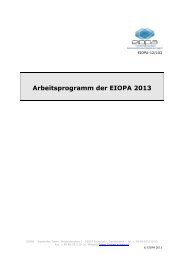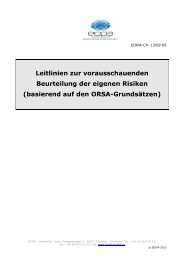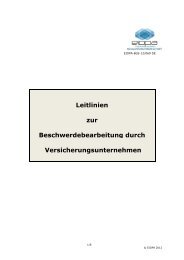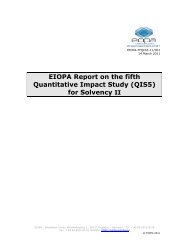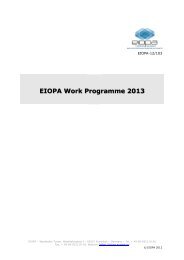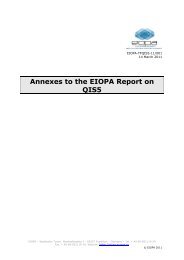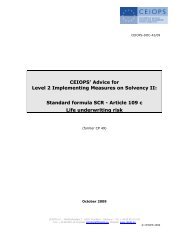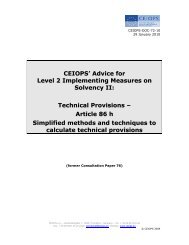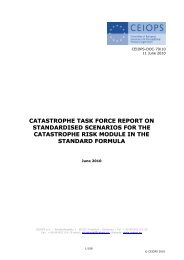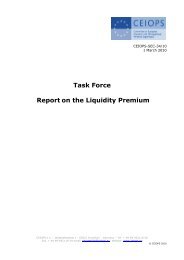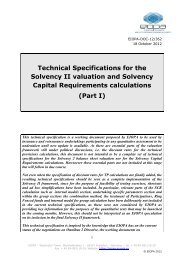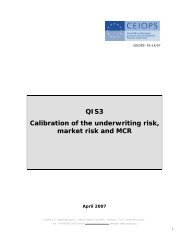Answers to the European Commission on the ... - Eiopa - Europa
Answers to the European Commission on the ... - Eiopa - Europa
Answers to the European Commission on the ... - Eiopa - Europa
You also want an ePaper? Increase the reach of your titles
YUMPU automatically turns print PDFs into web optimized ePapers that Google loves.
The narrower, actuarial view of <str<strong>on</strong>g>the</str<strong>on</strong>g> internal model is <str<strong>on</strong>g>the</str<strong>on</strong>g> system that<br />
transforms risk exposure data (how many c<strong>on</strong>tracts of which type are<br />
written) and risk driver data (his<str<strong>on</strong>g>to</str<strong>on</strong>g>ric informati<strong>on</strong> <strong>on</strong> <str<strong>on</strong>g>the</str<strong>on</strong>g> likelihood of<br />
certain events) <str<strong>on</strong>g>to</str<strong>on</strong>g> forecasts of profit and loss (P&L 98 ) distributi<strong>on</strong>s. In<br />
practice, an undertaking may use a collecti<strong>on</strong> of models that make<br />
predicti<strong>on</strong>s for <str<strong>on</strong>g>the</str<strong>on</strong>g> P&L at different levels of aggregati<strong>on</strong>. CEIOPS calls<br />
<str<strong>on</strong>g>the</str<strong>on</strong>g> whole system that transforms input data in<str<strong>on</strong>g>to</str<strong>on</strong>g> forecast P&L<br />
distributi<strong>on</strong>s <str<strong>on</strong>g>the</str<strong>on</strong>g> actuarial model 99 .<br />
11.15 However, <str<strong>on</strong>g>the</str<strong>on</strong>g> internal model is more than this mechanistic process. It<br />
should also encompass <str<strong>on</strong>g>the</str<strong>on</strong>g> way in which <str<strong>on</strong>g>the</str<strong>on</strong>g> actuarial model is<br />
integrated with <str<strong>on</strong>g>the</str<strong>on</strong>g> internal risk management system. Integrati<strong>on</strong><br />
dem<strong>on</strong>strates that <str<strong>on</strong>g>the</str<strong>on</strong>g> actuarial model is genuinely relevant <str<strong>on</strong>g>to</str<strong>on</strong>g> <str<strong>on</strong>g>the</str<strong>on</strong>g><br />
management of <str<strong>on</strong>g>the</str<strong>on</strong>g> business and has not been developed simply <str<strong>on</strong>g>to</str<strong>on</strong>g><br />
satisfy regula<str<strong>on</strong>g>to</str<strong>on</strong>g>ry requirements. Validati<strong>on</strong> and approval of <str<strong>on</strong>g>the</str<strong>on</strong>g> internal<br />
model should apply in this broader c<strong>on</strong>text, ra<str<strong>on</strong>g>the</str<strong>on</strong>g>r than focussing solely<br />
<strong>on</strong> <str<strong>on</strong>g>the</str<strong>on</strong>g> actuarial techniques <str<strong>on</strong>g>to</str<strong>on</strong>g> arrive at <str<strong>on</strong>g>the</str<strong>on</strong>g> forecast distributi<strong>on</strong>s or <str<strong>on</strong>g>the</str<strong>on</strong>g><br />
single SCR number.<br />
11.16 The actuarial model can also be used as a basis <str<strong>on</strong>g>to</str<strong>on</strong>g> derive <str<strong>on</strong>g>the</str<strong>on</strong>g> capital<br />
requirement. While <str<strong>on</strong>g>the</str<strong>on</strong>g> SCR estimate will be computed by <str<strong>on</strong>g>the</str<strong>on</strong>g><br />
undertaking, <str<strong>on</strong>g>the</str<strong>on</strong>g> way it is derived from <str<strong>on</strong>g>the</str<strong>on</strong>g> distributi<strong>on</strong>al forecast is<br />
fully specified by <str<strong>on</strong>g>the</str<strong>on</strong>g> regula<str<strong>on</strong>g>to</str<strong>on</strong>g>ry framework and hence not part of <str<strong>on</strong>g>the</str<strong>on</strong>g><br />
internal model. The distincti<strong>on</strong> between SCR estimate, Pillar I SCR and<br />
adjusted SCR does not imply that <str<strong>on</strong>g>the</str<strong>on</strong>g>re should necessarily be a<br />
difference between <str<strong>on</strong>g>the</str<strong>on</strong>g> three, but it facilitates <str<strong>on</strong>g>the</str<strong>on</strong>g> discussi<strong>on</strong> <strong>on</strong> how<br />
<str<strong>on</strong>g>the</str<strong>on</strong>g> link from <str<strong>on</strong>g>the</str<strong>on</strong>g> internal model <str<strong>on</strong>g>to</str<strong>on</strong>g> <str<strong>on</strong>g>the</str<strong>on</strong>g> SCR should be defined and in<br />
which pillar.<br />
Compliance Criteria<br />
11.17 For <str<strong>on</strong>g>the</str<strong>on</strong>g> actuarial model, three different aspects might be c<strong>on</strong>sidered:<br />
• input criteria: c<strong>on</strong>cerning, for example <str<strong>on</strong>g>the</str<strong>on</strong>g> quality of data and<br />
<str<strong>on</strong>g>the</str<strong>on</strong>g> scope of <str<strong>on</strong>g>the</str<strong>on</strong>g> model (what can and can’t be included);<br />
• process criteria: <str<strong>on</strong>g>the</str<strong>on</strong>g> inner logic for how <str<strong>on</strong>g>the</str<strong>on</strong>g> model should<br />
produce its required output; and<br />
• output criteria: for example, <str<strong>on</strong>g>the</str<strong>on</strong>g> requirement <str<strong>on</strong>g>to</str<strong>on</strong>g> produce a full<br />
distributi<strong>on</strong>, or <str<strong>on</strong>g>to</str<strong>on</strong>g> use a certain risk measure.<br />
11.18 SCR criteria set out how <str<strong>on</strong>g>the</str<strong>on</strong>g> output from <str<strong>on</strong>g>the</str<strong>on</strong>g> internal model is<br />
transformed in<str<strong>on</strong>g>to</str<strong>on</strong>g> a capital requirement.<br />
98 Within <str<strong>on</strong>g>the</str<strong>on</strong>g> answer <str<strong>on</strong>g>to</str<strong>on</strong>g> CfA11, “P&L” shall mean <str<strong>on</strong>g>the</str<strong>on</strong>g> change in ec<strong>on</strong>omic value (plus any intermediate cash<br />
flows) of assets minus liabilities over <str<strong>on</strong>g>the</str<strong>on</strong>g> time horiz<strong>on</strong> that is <str<strong>on</strong>g>the</str<strong>on</strong>g> basis for <str<strong>on</strong>g>the</str<strong>on</strong>g> SCR target. Within <str<strong>on</strong>g>the</str<strong>on</strong>g><br />
internal model, ec<strong>on</strong>omic valuati<strong>on</strong> and risk measurement need <str<strong>on</strong>g>to</str<strong>on</strong>g> be c<strong>on</strong>sistent.<br />
99 The ‘actuarial model’ is used as a short-hand for ‘<str<strong>on</strong>g>the</str<strong>on</strong>g> internal model in a narrower, quantitative, statistical<br />
sense’ in <str<strong>on</strong>g>the</str<strong>on</strong>g> rest of <str<strong>on</strong>g>the</str<strong>on</strong>g> answer <str<strong>on</strong>g>to</str<strong>on</strong>g> CfA 11. The use of <str<strong>on</strong>g>the</str<strong>on</strong>g> attribute ‘actuarial’ does, however, not imply that<br />
<str<strong>on</strong>g>the</str<strong>on</strong>g> actuarial model is solely within <str<strong>on</strong>g>the</str<strong>on</strong>g> resp<strong>on</strong>sibility of <str<strong>on</strong>g>the</str<strong>on</strong>g> actuarial functi<strong>on</strong> in <str<strong>on</strong>g>the</str<strong>on</strong>g> sense of A.22.<br />
118



